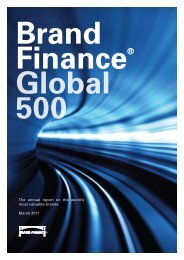Intellectual Property Valuation and Royalty ... - Brand Finance
Intellectual Property Valuation and Royalty ... - Brand Finance
Intellectual Property Valuation and Royalty ... - Brand Finance
Create successful ePaper yourself
Turn your PDF publications into a flip-book with our unique Google optimized e-Paper software.
1. Introduction<br />
The main objective of this chapter is to describe the factors that guide the determination of<br />
royalty rates for licensed intellectual property rights (IP). Key principles of IP valuation are<br />
also discussed as royalty rates <strong>and</strong> value are flip sides of the same coin; both are driven by<br />
the earnings capability of the asset.<br />
The most obvious need for a royalty rate is the negotiation of a licence; however, royalties<br />
are required for a variety of other purposes, including:<br />
� Transfer pricing: Within multinational corporations, the use of IP by entities operating in<br />
different tax jurisdictions results in a transfer of earnings. Tax authorities in developed<br />
markets are paying considerable attention to ensure that arm’s length royalties are<br />
charged. Guidance is provided in OECD Transfer Pricing Guidelines <strong>and</strong> country specific<br />
tax rulings.<br />
� Litigation: Damages claims resulting from IP infringements can be influenced by the level<br />
of royalties that are likely to have been agreed upon by the owner of the IP <strong>and</strong> the<br />
infringer. 1<br />
� Strategic planning: The management of IP portfolios benefits from the quantification of<br />
the current <strong>and</strong> potential strength <strong>and</strong> earnings of each asset. <strong>Royalty</strong> potential is an<br />
important metric in a review of an IP portfolio.<br />
� <strong>Valuation</strong>: One of the income‐based methods of IP valuation is based on the notional<br />
royalties that the property could generate.<br />
In turn, IP valuation can be required for financial reporting, tax compliance, pre‐acquisition<br />
due diligence, <strong>and</strong> strategic asset management.<br />
At the outset, it is helpful to compare different definitions of intangible items. Accountants<br />
use the term ‘intangible assets’ to describe non‐monetary assets without physical substance<br />
1 The legal issues associated with the calculation of damages in an infringement suit are beyond the<br />
scope of this Chapter, particularly since such issues often are dependent upon the law in the<br />
jurisdiction where suit was brought <strong>and</strong> thus, the jurisdiction calculating damages. For example, in the<br />
U.S., a reasonable royalty for purposes of a damages calculation often is determined in a<br />
“hypothetical” negotiation that evaluates various so-called Georgia-Pacific factors. See Georgia-<br />
Pacific Corp. v. United States Plywood Corp., 318 F. Supp. 1116 (S.D. N.Y. 1970). Moreover, in the<br />
U.S., damages in an infringement suit could include the patentee’s lost profits <strong>and</strong> the U.S. Courts<br />
apply a four-factor test for determining the propriety of lost profits damages, including (1) dem<strong>and</strong> for<br />
the patented product, (2) absence of acceptable non-infringing substitutes, (3) manufacturing <strong>and</strong><br />
marketing capability to exploit the dem<strong>and</strong>, <strong>and</strong> (4) the amount of profit the patentee would have<br />
made. See Ericsson, Inc. v. Harris Corp., 352 F.3d 1369, 1377-79 (Fed. Cir. 2003); Micro Chem., Inc.<br />
v. Lextron, Inc., 318 F.3d 1119, 1123 (Fed. Cir. 2003). See also P<strong>and</strong>uit Corp. v. Stahlin Bros. Fibre<br />
Works,, Inc., 575 F.2d 1152 (6th Cir. 1978).<br />
‐ 3 ‐ © Wolters Kluwer Law & Business












